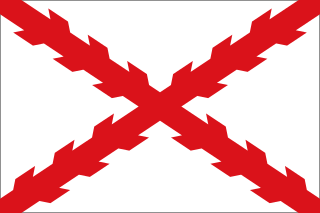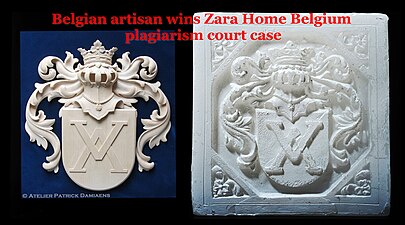
Flanders is the Dutch-speaking northern portion of Belgium and one of the communities, regions and language areas of Belgium. However, there are several overlapping definitions, including ones related to culture, language, politics, and history, and sometimes involving neighbouring countries. The demonym associated with Flanders is Fleming, while the corresponding adjective is Flemish, which is also the name of the local dialect. The official capital of Flanders is the City of Brussels, although the Brussels-Capital Region that includes it has an independent regional government. The powers of the government of Flanders consist, among others, of economic affairs in the Flemish Region and the community aspects of Flanders life in Brussels, such as Flemish culture and education.

The Seventeen Provinces were the Imperial states of the Habsburg Netherlands in the 16th century. They roughly covered the Low Countries, i.e., what is now the Netherlands, Belgium, Luxembourg, and most of the French departments of Nord and Pas-de-Calais (Artois). Also within this area were semi-independent fiefdoms, mainly ecclesiastical ones, such as Liège, Cambrai and Stavelot-Malmedy.
Vooruit is a Flemish social democratic political party in Belgium. The party was known as the Flemish Socialist Party until 21 March 2021, when its current name was adopted.

Wood carving is a form of woodworking by means of a cutting tool (knife) in one hand or a chisel by two hands or with one hand on a chisel and one hand on a mallet, resulting in a wooden figure or figurine, or in the sculptural ornamentation of a wooden object. The phrase may also refer to the finished product, from individual sculptures to hand-worked mouldings composing part of a tracery.

Industria de Diseño Textil, S.A. is a Spanish multinational clothing company headquartered in Arteixo, Galicia, in Spain. Inditex, the biggest fast fashion group in the world, operates over 7,200 stores in 93 markets worldwide. The company's flagship store is Zara, but it also owns a number of other brands such as Zara Home, Bershka, Massimo Dutti, Oysho, Pull&Bear, Stradivarius, Uterqüe and Lefties. The majority of its stores are corporate-owned, while franchises are mainly conceded in countries where corporate properties cannot be foreign-owned.

Alebrijes are brightly colored Mexican folk art sculptures of fantastical (fantasy/mythical) creatures.
Carl Johan Trygg, formally Carl Johan Thrygg, also knowns as C. J. Trygg, woodcarver, was one of the recognized masters of twentieth century woodcarving, most famous for Scandinavian flat-plane style of woodcarving. Between C. J. Trygg and his sons they carved over 10,000 figures. Many of his carvings were sold to tourists for approximately $10.00 USD. Adjusted for inflation what cost $10.00 in 1929 would cost $108.05 in 2005.

The Flemish Heraldic Council advises the Flemish Government on all matters relating to heraldry. The Council was created on 11 April 1984, as the successor to the Subcommittee for Heraldry or Subcommissie Heraldiek, established in 1978. Its prime task was to supervise the granting of a coat of arms and a flag to all municipalities of the Flemish Region. Following the reorganization of the Belgian provinces, the council's field of action was extended to provincial arms and flags in 1994. Since 2000, the Council has likewise advised the Flemish Government on grants of arms to Flemish individuals and corporations. In the meantime, more than 200 such grants have received official sanction. Grants of arms by the Flemish Government are published in the Belgian official journal.

Burgher arms or bourgeois arms are coats of arms borne by persons of the burgher social class of Europe since the Middle Ages. By definition, however, the term is alien to British heraldry, which follows other rules.
A heraldic authority is defined as an office or institution which has been established by a reigning monarch or a government to deal with heraldry in the country concerned. It does not include private societies or enterprises which design and/or register coats of arms. Over the centuries, many countries have established heraldic authorities, and several still flourish today.

Ben Harms was a German-born traditional woodcarver working in England. Some of his work can be seen at The Tower of London, Windsor Castle, Kensington Palace, Hampton Court and alongside the work of Grinling Gibbons at Petworth House.

Flemish people or Flemings are an ethnic group native to Flanders, Belgium, who speak Flemish Dutch. Flemish people make up the majority of Belgians, at about 60%.
Edward F. Gallenstein was an American woodcarver and editor, who served as the second President of the National Wood Carvers Association, during which time he was also the Editor-in-Chief of the woodcarving magazine Chip Chats.

The Dutch Republic Lion was the badge of the Union of Utrecht, the Republic of the Seven United Netherlands, and a precursor of the current coat of arms of the Kingdom the Netherlands.

The Belgian provincial, municipal and district elections of 2012 took place on 14 October. As with the previous 2006 elections, these are no longer organised by the Belgian federal state but instead by the respective regions:

Walter Langcake was an Australian woodcarver and sculptor, who specialised in ecclesiastical decorative arts.

Flemish (Vlaams) is a Low Franconian dialect cluster of the Dutch language. It is sometimes referred to as Flemish Dutch, Belgian Dutch, or Southern Dutch. Flemish is native to the region known as Flanders in northern Belgium; it is spoken by Flemings, the dominant ethnic group of the region. Outside of Belgium Flanders, it is also spoken to some extent in French Flanders and the Dutch Zeelandic Flanders.

Belgian heraldry is the form of coats of arms and other heraldic bearings and insignia used in the Kingdom of Belgium and the Belgian colonial empire but also in the historical territories that make up modern-day Belgium. Today, coats of arms in Belgium are regulated and granted by different bodies depending on the nature, status, and location of the armiger.

National symbols of Belgium are the symbols used to represent the Kingdom of Belgium. Article 193 of the Belgian Constitution is dedicated to specifying the national flag, colours, coat of arms, and motto. It says the following: "The Belgian nation takes red, yellow and black as colours, and as state coat of arms the Belgian lion with the motto Unity makes strength."
Françoise Chombar is a Belgian businesswoman. She is the current CEO and one of the original founders of the semiconductor company Melexis. She took over as a CEO from her husband and co-founder Rudi de Winter in 2004, having previously served as the COO of the company since 1997. She is also a non-executive board member for Soitec and Umicore, and a member of the Advisory Board at Byteflies.




















